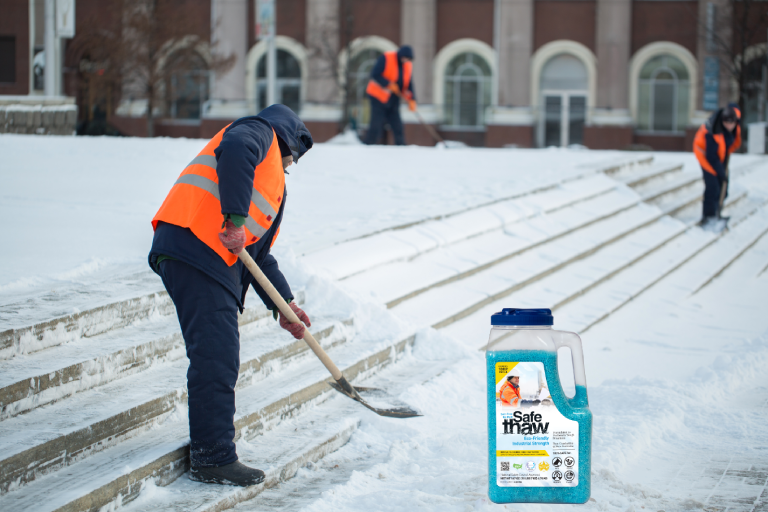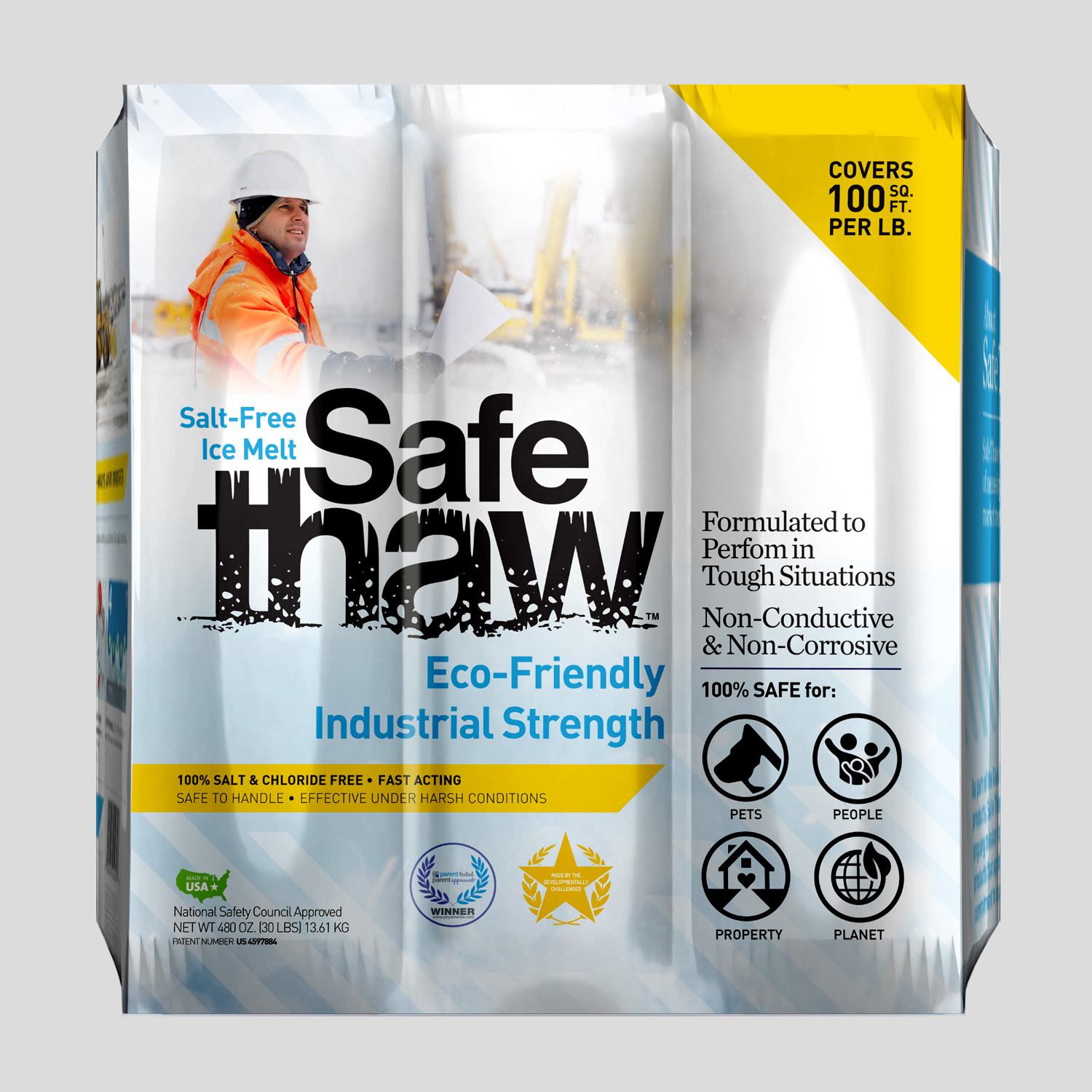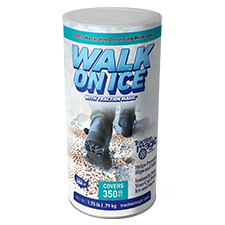The Ideal Temperature To Pour Concrete: A Comprehensive Guide for Homeowners

In the world of home construction projects, understanding the significance of the temperature to pour concrete can mean the difference between success and failure. The pouring temperature significantly impacts the strength, durability, and overall quality of your concrete project. So, what’s the right temperature?
Generally, the optimal temperature to pour concrete falls within the 40-60 °F range. This range facilitates proper curing, paving the way for a robust and durable concrete structure.

Blizzards Are Here—Stock Up on Safe Thaw Today!
Safe Thaw was created as the ice management solution for tough winter environments. Ideal in commercial and industrial properties, shops, government agencies, bridges, and construction.
Temperature Extremes And Concrete Pouring: What Are The Risks?
Pouring concrete in extreme temperatures comes with its set of challenges. Let’s delve into some of the problems associated with such scenarios:
Cold Temperatures: Pouring concrete when it’s freezing can lead to serious complications. Water in the mix might freeze, causing the concrete to expand and crack, thereby compromising the structural integrity of the project and leading to expensive repairs. Also, the hydration process slows down in colder temperatures, extending the project timeline and making the fresh concrete susceptible to damage.
Hot Temperatures: In contrast, hot temperatures lead to accelerated hydration, making it difficult to properly work with the concrete. This could result in surface defects and a decrease in strength. The rapid drying of the concrete could lead to shrinkage and cracking, hampering both the aesthetics and structure of the project.
Winter Storms Are Here!
Stay Safe with Our 100% Salt And Chloride-Free, Pet Safe Ice Melt.
The Importance Of Temperature During The Concrete Curing Process
The temperature at which concrete cures plays a vital role in its overall quality. High temperatures can lead to faster setting and hardening, reducing workability and potentially leading to cracks. Lower temperatures, however, slow down the curing process but can also lead to freezing in extreme conditions.
Ensuring consistent temperatures throughout curing helps achieve the desired strength, durability, and overall quality.
Variables Affecting The Temperature To Pour Concrete
Various factors can influence the temperature during the pouring and curing of concrete. These include:
- Ambient Temperature: The surrounding air temperature significantly influences concrete temperature. It can either cool or heat the concrete rapidly, impacting its curing and strength development.
- Concrete Mix Temperature: Known as the “batch temperature,” the initial temperature of the mix also plays a pivotal role. Higher temperatures accelerate hydration, while lower ones slow it down.
- Subgrade and Formwork Temperature: The temperature of the subgrade and formwork can also impact the temperature of the concrete. It’s crucial to manage these elements to maintain the desired temperature during placement.
100% Salt & Chloride-Free Ice Melt for Winter Storm Protection.
Concrete Pouring Best Practices For Different Temperatures
Whether you’re working in cold or hot weather, the following tips can help ensure a successful concrete project:
- Cold Weather Tips: Start by thawing the ground and using insulated blankets. Also, consider using accelerators or hot water in the mix to promote curing.
- Hot Weather Tips: Control the concrete’s temperature during mixing. Use chilled water and admixtures, work swiftly, and consider shading the site to reduce sunlight impact.
- Protection: Cover the concrete with curing blankets or plastic sheets to retain moisture and prevent rapid evaporation.
- Adjustments: Consult with a professional to adjust the concrete mix design according to the temperature conditions.
- Monitoring: Regularly monitor the concrete’s temperature during curing using sensors or thermometers.
Maintenance Tips For Your Concrete Project
After your concrete project, protect your investment and prevent future damage by adopting the following practices:
- Cleaning and Inspection: Regularly sweep away debris and conduct routine inspections to identify and promptly tackle any issues.
- Winter Maintenance: During winter, use non-toxic, eco-friendly, concrete safe ice melt alternatives like Safe Thaw to melt ice effectively without damaging the concrete.
- Sealing: Apply a high-quality concrete sealer to provide an extra layer of protection against moisture, stains, and harsh weather.
- Mindful Landscaping: Avoid planting trees or shrubs with aggressive roots near the concrete to prevent cracking.
- Heavy Load Prevention: Avoid placing heavy objects or parking vehicles with sharp edges directly on the surface. Use protective pads or mats under heavy equipment and vehicles.
Remember, understanding the temperature to pour concrete is essential for any homeowner undertaking construction projects. Always use a concrete safe ice melt. The temperature plays a pivotal role in the curing process, affecting the concrete’s strength and longevity. Therefore, taking the necessary precautions and adjusting the mix and curing methods accordingly can help you achieve optimal results. So, before you embark on your next concrete project, pay close attention to the temperature to pour concrete and set yourself up for success.
Try Also Our Other Winter Safety Products:
Safe Paw
The Original and #1 Selling Pet and Child Safe Ice Melt for over 20 years. Guaranteed environmentally safe –It won’t harm animals or children, and it won’t damage your property. That’s Safe Paw. Safe Paw can change how winter affects our planet.

Walk On Ice
The handy disposable canister can be taken everywhere, with the same 100% naturally occurring minerals that provide instant traction on ice or snow. Use it on sidewalks, steps, or as an instant traction agent for your car.



